The last post concluded with our arrival at the fishing port of Sada, province of A Coruna, in the autonomous community of Galicia on August 14th – in the far NW corner of Spain.
Unfortunately, that entire day I had felt a cold coming on, and it caught up to me about the time we arrived in Sada. Our plans for the next day (August 15) were to visit Santiago de Compostela, according to legend, the burial site of Saint James the Apostle.
But first things first – I wanted something to combat the cold, so after breakfast we went in search of a pharmacy.
In Spain, it seems like the only place to get medications — over-the-counter or prescription — is at a pharmacy. They seem to be comparatively expensive, as well … but I digress.
Did you know that August 15 was Assumption Day? I didn’t either. Spaniards in general do not seem to be particularly religious, but they love celebrating religious holidays and almost every business in Spain was closed in celebration. We couldn’t find any pharmacies open in Sada.
So we headed for Santiago without my drugs – Teresa drove and I navigated the 80km distance. We must have gone through 4 or 5 good-sized towns before finding an open pharmacy. And since it was Assumption Day, locally celebrated by all manner of parades and road races (running/bicycling/etc), my rudimentary navigation skills were sorely tested by unplanned detours caused by these same parades and races.
We arrived in Santiago about 11am or so – my cold symptoms abating for now, found a parking garage not so awful far from the Cathedral of Santiago de Compostela, and walked towards it. This is mid-August, the height of the height of tourist season, but it was still not too crowded yet … that early in the morning. We waded through the throngs crowding the narrow passageways towards the Cathedral until finally we got close enough to see the main entrance. Oops …
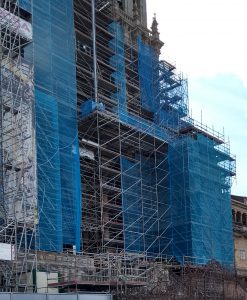

this side is closed off for repair until later this fall, and we didn’t get the memo… But we are told the statuary is the best in Spain. Anyway, you can see the facade right here on the 1, 2 and 5 cent Spanish Euro coins. From that courtyard to the one on the other side of the cathedral, one must walk through a narrow passage and listen to the buskers playing tunes for tourists. On our pass through, we heard a Galician bagpiper. Apparently, bagpipes are really a thing here in Galicia and northern Portugal, and in Asturias as well, due to the Celtic influences on these coastlines.
On the other side of the Cathedral was another large courtyard with many exhausted pilgrims limping toward the finish line. The Camino de Santiago is a network of paths leading from various points in France and the Iberian Peninsula to the Cathedral of Santiago de Compostela. For centuries it has served as a path for Christian pilgrims traveling to Galicia, and more lately it has become very popular with hikers and cyclists as well. We crossed various threads of the trail many times during this trip. IMHO, the trail through Asturias would probably be the most scenic of the possible routes – although it is not as well known and therefore more lightly traveled.
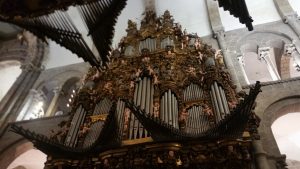

In this courtyard, there was also a queue of people waiting their turn for entry to the Cathedral, and we joined the line. We were able to observe carvings of the apostles on the exterior of the building as well as a fantastic looking pipe organ. I couldn’t help but wish that some of my keyboard player friends were there to witness it as well.
On Wednesday August 16 it was time to head east again. We had an AirBnB booked for Leon – the capital city of the Province of Leon. Our route took us through Lugo (capital of the province of Lugo) and we wanted to stop
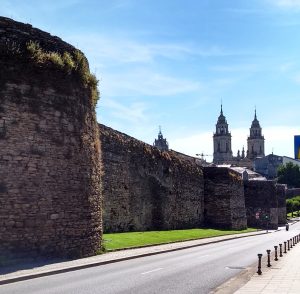
there to see the Roman wall surrounding the old city – which is still quite intact. You can walk on top of the wall all the way around the old town.
On the 17th we visited the Leon Cathedral, renowned for its huge expanses (~19000 sq ft, almost half an acre!) of stained glass among other things. In the afternoon, we backtracked a bit to visit the site of the richest gold mine in the Roman Empire, Las Medulas. The Romans used a mining technique called ruina montium (mountain wrecking) to undermine the mountains and leave an otherworldly land-
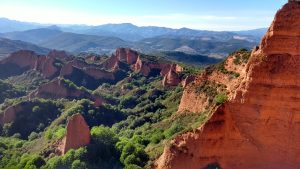
scape. Pliny the Elder apparently observed the site while it was being mined and described it like this: What happens is far beyond the work of giants. The mountains are bored with corridors and galleries made by lamplight with a duration that is used to measure the shifts. For months, the miners cannot see the sunlight and many of them die inside the tunnels. This type of mine has been given the name of ruina montium. The cracks made in the entrails of the stone are so dangerous that it would be easier to find purpurine or pearls at the bottom of the sea than make scars in the rock. How dangerous we have made the Earth! I like to think he would be aghast at the mountaintop removal mining that goes on nowadays…
The area has since regrown prolifically in Chestnut, and we enjoyed a delicious chestnut torte at a roadside cafe we encountered while hiking. I do wonder how long it took for trees to again take root in the ruined landscape.
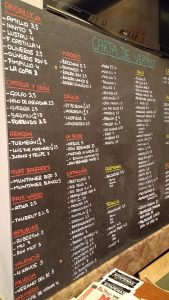
While we were hiking this area, I got a WhatsApp message from my daughter Amelia inquiring about our safety since she had just heard about a terror attack in Barcelona. We were fortunate to be away from the city at the time. That evening, we returned to Leon, grabbed a bite to eat and wandered about until we encountered a Vermutaria. We had no idea that there were any bars devoted solely to Vermouth, or that such a constellation of varieties existed!
Friday, the 18th … unfortunately, my cold came with a very sore throat, headache and a bit of fever, so I was taking medications that put me in a bit of a stupor. And now Teresa was beginning to come down with the same cold. We slept in as late as we could, then set out for our last stop — in Logrono, La Rioja — renowned for its wine and food culture. From Leon, we passed by Burgos before entering La Rioja — where almost immediately the landscape changes to grape cultivation. We heard there was a good museum in Briones dedicated to wine culture and we stopped in.
The Vivanco Museum of Wine Culture is hard for me to describe in retrospect, but wine is a very important part of European and Middle Eastern culture and it is definitely worth a visit
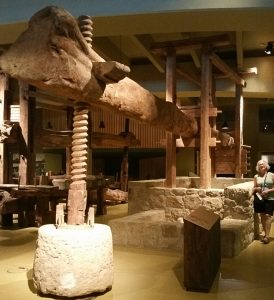
should you ever get to La Rioja. There were displays on the process – from grape cultivation to harvest to crushing to fermentation … Another hall was devoted to barrel, bottle and cork making, as well as other necessary trades to support the winemaker. A third hall is devoted to racking, fining, tasting – you wine and beer making enthusiasts among the readers would find this fascinating. Another hall has an impressive selection of art related to wine. And don’t forget the worlds largest collection of corkscrews!
When we finally got to Logrono (capital of La Rioja), we were both tired and sick, and not really in the mood to go out — but we were hungry for a little something and we went to the old section of town. Logrono is a city of about 150,000 and does not loom large on the main tourist routes throughout Spain. But the food and wine are amazing!! Even though we were sick and in no shape to fully appreciate what was on offer there, we were still blown away by the pinxto bar scene.
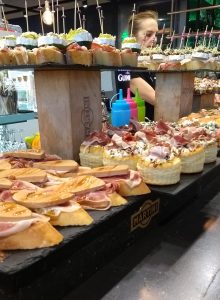
There are two short, narrow streets: Calle de San Juan and Calle del Laurel. Both of them are lined with Pinxto bars/restaurants and that is the place to be after 8pm. (None of them are open at 7pm). When you enter one of these establishments, the first thing you will notice is a vast and wonderful array of platters of different types of pinxtos. Some of them are quite elaborate looking works of art. The ones we ordered came with a glass of very good wine. Cost for the wine and snack was about 2.25 euros each. As good as the breakfast pinxtos on the right look – they do not do justice to the platters we saw in Logrono. But they did make a fine breakfast indeed, one week earlier in Bilboa!
San Sebastian, on the coast to the Northeast of Logrono is reputed to have the finest cuisine in Spain – better even than Logrono. We felt that there was not enough time on this trip to explore San Sebastian properly so we are intending to go up there sometime this fall for a few days to find out for ourselves.
On Saturday the 19th, we packed the car again and returned to our apartment in Barcelona.
Salud!
Thanks for sharing another cool adventure, despite the virus! I’d have liked tbeen one of those keyboarder friends.
It would be fabulous to sit in on a jam session with pipes like that! My spine tingles just to think of it!
This sounds like quite the adventure. We sure hope you are both feeling better now. Did they have corkscrews for sale. How did they make corks for the wine bottles? Did you find Atlantis in your travels? Spain is thought to be where the protectors of Atlantis were centered. Feel better, take care.
Cork making – perhaps we can show you the process when you visit next year …
Atlantis – just beyond the Pillars of Hercules … which we didn’t see. We were close to the Tower of Hercules in A Coruna but we’ll have to see that on the next trip.
We are feeling great again, thanks!